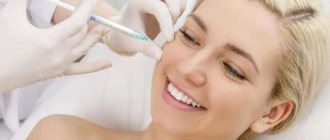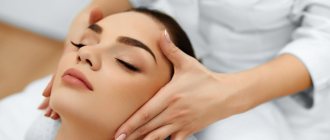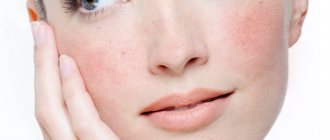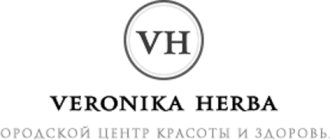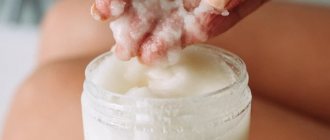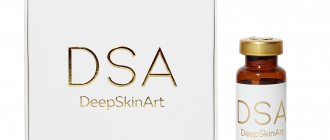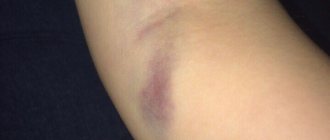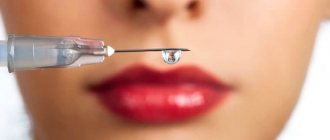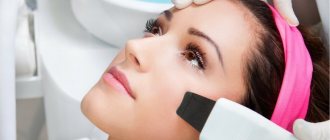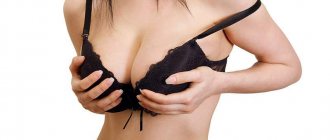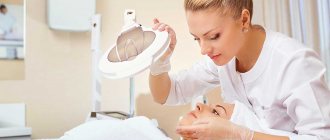From this article you will learn:
- biorevitalization: what kind of procedure is it, reviews,
- photos of patients before and after,
- injection and non-injection techniques,
- how much does biorevitalization cost - price for 1 procedure (for 2021).
Facial biorevitalization is a procedure for intradermal injection of high concentrations of active substances, which can significantly improve the appearance of the skin, increase its elasticity, as well as achieve a lifting effect and reduce the depth of wrinkles. Most often, hyaluronic acid, vitamins, microelements, amino acids are used for this, and in older age - components for intensive skin lifting, for example, peptides, DNA-RNA complexes and DMAE.
The composition of the drug is selected individually for each patient. The age of the patient, the condition of the facial skin, and, what is very important, the type of skin aging are taken into account. For example, for fine-wrinkle and deformation types of aging, completely different drugs will be indicated. An important problem is the training of specialists. How often, for example, do mesotherapists tell patients that capillary mesotherapy must be done before administering biorevitalizants? But in many cases, the severity and duration of the biorevitalization effect will depend on this.
Biorevitalization: photo of the procedure
Indications for biorevitalization –
- therapy for biological skin aging,
- photoaging therapy (including hyperpigmentation and rosacea),
- prevention of aging,
- wrinkles, thinning, decreased elasticity, dry skin,
- deterioration of the skin as a result of smoking (including the appearance of small vertical wrinkles on the lips).
Thus, the biorevitalization technique will allow you to improve the color and texture of the skin (especially for smokers), increase its elasticity, reduce the depth of wrinkles, and achieve a skin lifting effect. Additional effects of this procedure may include correction of hyperpigmentation, reduction in the severity of rosacea, as well as inflammatory elements of acne. The severity of a particular effect will directly depend on the composition of the chosen drug.
Differences between biorevitalization and mesotherapy -
Mesotherapy and biorevitalization of the face and neck are very similar procedures and are performed by the same specialists - mesotherapists. So how are they different? When it comes to intensive rejuvenation of the face and neck (using high concentrations of active ingredients), the term “biorevitalization” is used. Mesotherapy uses lower concentrations of active components, and this procedure can be performed not only on the face, but also on the body.
Thus, when it comes to the correction of cellulite or local fat deposits on the body, or procedures are carried out to improve the condition of the hair and scalp, or to improve the condition of the skin of the face and neck (but with low dosages of active substances) - this is called the term “ mesotherapy". If intensive rejuvenation and lifting of the skin of the face/neck is required, then drugs with high concentrations of active substances are used, and in this case the terms “biorevitalization” or “bioreparation” are used.
For example, the concentration of hyaluronic acid (HA) in mesopreparations is usually only from 0.3-0.5%, which corresponds to 3-5 mg/ml, and in biorevitalization products it is usually from 1.5 to 2.0% (= 15-20 mg/ml). Accordingly, in the second case, the saturation of the dermis with moisture will be much more intense, and this will lead to a more noticeable lifting effect. It is also worth noting that low molecular weight HA (with a molecular weight of about 800 kDa) is usually used in mesotherapy, and high molecular weight HA (from 1800 to 3000 kDa) is used in biorevitalization procedures.
An important point is that mesopreparations are made on a water or sol basis (sol is a liquid gel), and biorevitalizants are produced in the form of viscous gels. This greatly affects the time of drug deposition in tissues. Those. if in the first case, the drugs quickly spread in the tissues and are quickly eliminated from them, then in the second case, a drug depot is created in the tissues (at the site of each injection) for a period of approximately 2-3 weeks. That is why it is customary to inject mesopreparations once a week, and biorevitalizants - usually once every 2-3 weeks. Such differences between mesopreparations and biorevitalizants affect not only the frequency, but also the required number of procedures.
Benefits of biorevitalization
- Firstly, the quality of the skin, especially mature skin, noticeably improves, this is visible and felt almost immediately: the skin seems to fit more tightly, a pleasant feeling. And after another two weeks, it becomes noticeably more elastic and full, acquiring a healthy, radiant appearance.
- Secondly, biorevitalization not only provides a positive cosmetic effect (of course, in the absence of allergies to drugs and contraindications), but also rehabilitates tired skin and prevents aging at the cellular level.
- Thirdly, the cost of the procedures, although not cheap, is affordable for many. New generations of drugs are emerging that are inexpensive and effective.
Does this mean that there are no negative consequences after biorevitalization? No, because this is still a medical intervention. But negative consequences most often arise due to our own neglect of safety rules and/or the recommendations of a cosmetologist. These rules are not so complicated, they are not difficult to follow.
Biorevitalization with hyaluronic acid: rationale for effectiveness
Age, ultraviolet radiation, smoking and some other factors lead to gradual aging of the skin. All this leads to a gradual decrease in the activity of fibroblasts and the content of hyaluronic acid (HA) in the skin. A decrease in the activity of fibroblasts leads to a decrease in the production of collagen and elastin, which allows the skin to be firm and elastic, and due to a decrease in the level of HA in the skin, its hydration decreases. As a result, the skin becomes drier and thinner, less elastic, and wrinkles appear.
According to the developers of the biorevitalization method, facial skin rejuvenation occurs by stimulating the activity of fibroblasts that produce collagen and elastin. In addition, the skin’s production of its own HA, which allows it to be more hydrated, also depends on the activity of fibroblasts. For example, if at the age of up to 25 years fibroblasts work at 100%, then in people 25-35 years old their number and activity decrease to 75%, and at 35-45 years old - to 50%, and after 50 years or after menopause in at any age - their number and activity are no more than 25% (compared to young people).
Preparations with low molecular weight HA tend to stimulate angiogenesis and fibroblast function, but at the same time they do not moisturize the skin quite well, because Small HA chains are not able to hold many water molecules (24stoma.ru). But high-molecular HA does not stimulate anything, but retains water well, thereby perfectly moisturizing the skin. Biorevitalizants with HA are indicated primarily for patients with finely wrinkled and tired types of aging, but their use in patients with deformational (edematous) type of aging will only lead to increased swelling and gravitational ptosis of soft tissues.
It is worth saying that now mesopreparations and biorevitalizants with hyaluronic acid are used in most cases by specialists thoughtlessly, because It is believed that the larger the HA, the better. But that's not true. The fact is that when carrying out frequent injections with HA, the latter not only stimulates the activity of fibroblasts or increases skin hydration. Frequent use leads to the activation of enzymes: 1) hyaluronidase - an enzyme that destroys endogenous hyaluronic acid produced by fibroblasts, 2) metalloproteinases - enzymes that destroy the intercellular matrix. Therefore, in fact, you should not do injections with HA more than once a month, and it is better to alternate them with other groups of drugs.
Advantages and disadvantages of the method
Biorevitalization has a number of advantages that make it stand out from other cosmetic procedures. First of all, with its help it is possible to give the face freshness and the skin an inner glow. It allows you to improve the shape of your face, as well as reduce fine wrinkles, not artificially, but by restoring the structure of your own tissues. And since the method involves the use of hyaluronic acid natural to the skin, it is safe.
In general, the advantages of biorevitalization are considered:
- natural renewal of skin cells and inhibition of aging processes naturally;
- ease of preparation for the procedure;
- speed of execution (biorevitalization requires no more than an hour);
- minimal level of pain when administering hyaluronic acid preparations;
- rapid skin restoration;
- obtaining a visible result a week after 1-2 sessions and maintaining it for a long time;
- a small number of absolute contraindications;
- affordable price, especially in comparison with other cosmetic procedures that have a rejuvenating, moisturizing effect.
But biorevitalization also has certain disadvantages. First of all, it is necessary to undergo a course of procedures to obtain a lasting, pronounced result.
The second drawback is largely due to the popularity of the procedure, which leads to the fact that today it is done even in beauty salons by “specialists” without medical education. In order for biorevitalization to be effective and safe, the specialist performing it must understand the structural features of different types of skin in different areas of the face, individually select the depth of drug administration and know which areas should be avoided. Only a certified cosmetologist who has received a full medical education can have such knowledge, since it is impossible to thoroughly understand the numerous features of the skin during short-term courses.
As a result of biorevitalization being carried out by non-professionals, who often are not even convinced that there are no contraindications to it, the frequency of unwanted effects sharply increases, not to mention the low effectiveness of the procedure. In some cases, patients even have to seek help from plastic surgeons after such procedures to eliminate the consequences of improper administration of hyaluronic acid. This is why you can find the most polarizing reviews about biorevitalization online, especially when treating the skin around the eyes.
You can only trust biorevitalization to a certified cosmetologist working in a medical center!
Thus, biorevitalization really has many advantages, and its only objective disadvantage is the need for periodic repetition. This, however, is typical for almost all cosmetic procedures. At the same time, it is a safe method of improving the condition of the skin, but only when performed by a qualified cosmetologist with a medical education.
Biorevitalization technique –
There are several injection techniques - nappage, papules, tubercles, as well as the linear-retrograde technique.
If all of them are used in mesotherapy, then when carrying out biorevitalization - everything except the “nappage” technique, which is associated with the inability of this technique to achieve deposition of the drug in the dermis. Before the biorevitalization procedure, superficial anesthesia of the skin is required using gels and creams containing from 5 to 12% of the anesthetic lidocaine. The cream is applied to the face for 15-20 minutes (under the film).
Papules (superficial or medium) –
This technique involves injections into the dermal layer of the skin, in such a way that at the site of each injection a “papule” will form, which looks like an elevation above the surface of the skin (Fig. 5). The size of the papules will depend on the volume of drug removed at each injection point. Papules can be small (micropapules), having a diameter of 1-2 mm, in which case injections are performed into the upper layers of the dermis. Each injection produces a volume of the drug of about 0.01-0.02 ml, the distance between papules is about 0.3 to 0.5 cm. Micropapules are usually made in areas with thin skin, for example, in the periorbital zone.
In areas with dense skin, papules are made of medium size - 3-4 mm in diameter, injecting 0.03-0.04 ml of the drug with each injection. The needle will penetrate into slightly deeper layers of the dermis, and the distance between papules should be about 1.5 cm. It should be noted that the larger the papules, the slower they will resolve. Usually papules disappear within 3 days, and in rare cases – up to 5-7 days. But if the doctor made medium-sized papules using a drug with partially stabilized hyaluronic acid (doctor’s mistake), then we can sympathize with you, because they will dissolve in about 3 weeks.
Superficial papules: video
Technique “tubercles” –
This technique has a big advantage, because... after it, the skin at the injection sites is practically invisible, and only traces of needle injections are visible. If with the “papules” technique injections are made with a needle placed at an angle of 15 degrees to the surface of the skin, and thus a drug depot is created in the upper or middle layers of the dermis, then with the “tubercles” technique - injections are made with a 4 mm needle at 45 degrees in the skin surface . Thus, the drug depot is created in the deeper layers of the dermis (at a depth of about 3 mm).
The distance between injections is 1.0 on the face, on the neck it is usually 1.5 cm. The disadvantage of this technique is that it is more difficult to control the volume of drug removal at each point.
Linear-retrograde technique –
This technique came from contouring, and most mesotherapists do not like it, because... technically it is the most difficult. However, it is also the most effective, and the same technique is also used for bioreinforcement of the face. If for previous techniques 4 mm needles are used, here they are 12-13 mm long. After injection, the needle is given a horizontal position, and it advances in the middle layers of the dermis parallel to the surface of the skin for its entire length. The drug is administered by retrograde movement of the needle backwards.
This technique is successfully used in the middle and lower thirds of the face - in the area of the cheekbones, cheeks, chin, corners of the mouth, facial contours (strictly along massage lines), in the neck area, and also around the eyes. It allows you to reduce the number of needle injections several times, thereby reducing the rehabilitation period. Advancing the needle 13 mm into the dermis leads to more pronounced subdermal damage (than when using 4 mm needles), which means tissue regeneration will be more active. This means that collagen synthesis will increase not only due to the introduction of active substances, but also in response to damage.
Linear-retrograde technique: video
Important: the biorevitalization procedure itself will take about 15-20 minutes. After the procedure, the skin is treated with a chlorhexidine solution. However, the indicated time does not take into account the lymphatic drainage vascular injection of the face and collar area, as well as the 15-20 minutes required to apply a special mask to the face, which will help minimize the visibility of needle injection marks and relieve redness.
How to prepare for biorevitalization
There are several important rules for preparing for biorevitalization; a good specialist will definitely tell you about them:
3 days before injections, you should not take aspirin or other blood thinning medications. If you neglect this rule, during injections there is a higher risk of bruising and bleeding, and the skin will take longer to heal.
For the same reason, it is advisable to exclude alcohol, energy drinks and tonic drugs on the eve of the procedure. Such as ginseng and ginkgo biloba.
Plan the procedure for a weekend or vacation, as it will take you 2 to 5 days to restore your appearance. In addition, alcohol is not advisable after the procedure, so do not do biorevitalization on the eve of possible celebrations.
Important: selection of drugs for biorevitalization
In practice, we most often encounter 2 types of skin aging. Firstly, a finely wrinkled type of aging, which appears already by the age of 30, and in the eye area even earlier. This type is characterized by thin, dehydrated skin and a large number of small expression wrinkles, especially in the eye area. For this type of aging, the use of hyaluronic acid (HA) is a priority. And if in young patients 25-30 years old it is still possible to use biorevitalizants containing only HA, then in patients 30-35 years old the biorevitalizant must already contain vitamins, microminerals, amino acids, and antioxidants.
In patients aged 35-40+ years with a fine wrinkled type, the biorevitalizant should preferably contain (in addition to the above components) nucleotides and matrikin peptides. The latter stimulate collagen synthesis. Moreover, after 30-35 years with this type of aging, in order to achieve a good effect, it is desirable to carry out in parallel 2-3 procedures of capillary mesotherapy of the face, neck, collar area with vascular / drainage drugs - to stimulate lymphatic drainage and blood supply to the skin.
But if patients of this type show symptoms of skin photoaging - such as hyperpigmentation and telangiectasia, then additionally vitamin C, antioxidants (glutathione, coenzyme Q10, thioctic acid), cysteine, lightening peptides will be needed. Vitamin C and antioxidants relieve oxidative stress that occurs when exposed to solar radiation. A drug with this composition will also be useful before going on vacation to hot countries.
Deformation type of aging - but the main type of aging of most Russian women is deformation (edematous). Such patients usually have dense skin, fairly few wrinkles, a large volume of soft tissues of the face due to interstitial edema of the subcutaneous fat, and also have pronounced nasolabial folds and jowls. This type of aging develops due to impaired venous outflow in the face and neck, and is provoked primarily by problems with the cervical spine. If such patients are given drugs with GC, this will further increase the swelling of the face and, as a result, gravitational ptosis of the soft tissues.
Therefore, in such patients, capillary mesotherapy (lymphatic drainage vascular injection) takes first place, as well as, according to indications, the use of lipolytics in the area of fat pads of the face and double chin. During the first 2-3 visits, capillary mesotherapy can be carried out as a single procedure, or it can be combined immediately with the introduction of biorevitalizants. The latter, in case of deformation/edema type of aging, should contain DNA-RNA complexes, as well as vitamins (primarily vitamin C), amino acids, and peptides.
Why is “capillary mesotherapy” (vascular injection) needed?
It is impossible to achieve a pronounced biorevitalization effect (primarily with the deformation type of aging) without stimulating the blood supply to the skin and activating lymphatic drainage. This injection is carried out with vascular preparations “Artichoke”, “Gingko Biloba”, “Rutin + melito extract” or “GAG Complex DVL Capyl”. This is especially true for patients with ptosis, rosacea or complaints of facial swelling. In all these groups of patients, lymphatic drainage vascular injection of the face and cervical-collar area should be done at least 4-5 times.
The volume of vascular preparations per procedure should be no more than 5 ml. First, the cervical-collar area is treated, then injections are made in the projection of the lymph nodes - the area of the earlobes, the sternocleidomastoid muscle, in the area of the jugular fossa and clavicles, as well as in the submandibular area. After this, a series of injections are made along the massage lines of the face and the infraorbital area. In patients with a finely wrinkled type of aging, it is advisable to do 1-2 such vascular puncture procedures, but in patients with a deformational type of aging or patients over 45 years old, 5 or more procedures can be safely performed.
The combination of the drainage drug “Artichoke” with the vascular drug “Rutin + melito extract” will normalize venous outflow, activate lymphatic drainage and microcirculation. All this will remove interstitial edema of the subcutaneous fat, which will reduce the volume of soft tissues and the degree of gravitational ptosis, as well as the severity of the folds. If a patient is prescribed a course of several biorevitalization procedures, then each procedure begins first with a vascular puncture and only after that are injections of the biorevitalizant given. Or the first 2-3 procedures are done only by capillary mesotherapy + soft lipolytics on the face, and biorevitalizants are added only from the 4th procedure.
Contraindications
Facial biorevitalization is not suitable for everyone. Sometimes it is worth holding off on injections, and in some cases, choosing a different method of rejuvenation.
- Pregnancy and breastfeeding. No specialist can be completely sure how the effects of the drug will affect the health of the expectant mother and the quality of breast milk. Due to weakened immunity during pregnancy, the skin may overreact to injections.
- Inflammation. First, it is better to wait for the wounds to heal, and then carry out rejuvenating procedures.
- Autoimmune diseases and other diseases in exacerbation. With multiple sclerosis, rheumatoid arthritis, and HIV, immunity is constantly under threat. Exposure to a chemically created drug may cause unexpected reactions or complications. If your illness is temporary - for example, you caught ARVI - you can come to the session after complete recovery.
Contraindications also include:
- allergy to hyaluronic acid;
- tumors;
- diabetes;
- epilepsy.
Moles are not an obstacle to anti-aging procedures. This is a common misconception. During the session, the drug is administered only to the area around the moles.
You should not carry out biorevitalization on critical days. Many procedures at this time are more painful.
Do not hide anything, otherwise the results of the sessions may disappoint you. Some of the best dermatologists in Lobnya work at the PrivatKlinik medical center, but without complete knowledge of the characteristics of your body, even they will not be able to provide you with ideal skin.
How to choose a drug for biorevitalization -
Preparations for biorevitalization are currently produced by countless companies.
One of the main components for these purposes are hyaluronic acid (HA) molecules. Typically, the lifespan of chemically unmodified (unstabilized) HA molecules is only 24 to 48 hours. However, biorevitalizants are produced in the form of a viscous gel, which allows even unstabilized HA to be deposited for a slightly longer period, reducing the rate of its destruction. The properties of the drug are very dependent on the molecular weight of the HA chains. High molecular weight HA (from 1500 to 3300 kDa) moisturizes the skin well, but does not have a stimulating effect on fibroblasts. Low molecular weight HA has a stimulating effect on fibroblasts and angiogenesis, but rather weakly moisturizes tissues. At the same time, low-molecular HA is destroyed faster in the skin than high-molecular HA (unless, of course, it has been chemically modified). For example, the preparation “Ial-system ACP” contains stabilized low-molecular HA with a molecular size of 200 kDa.
According to the manufacturer, the degradation period of HA in this drug is 10 days, and given the size of the molecules, one can immediately understand that the drug mainly has a stimulating effect on fibroblasts, activating collagen synthesis in them, but the moisturizing effect of such a drug will be less pronounced than if we will use a drug with high molecular weight HA with a molecular size of, for example, 1800 kDa or more. Next we look at the percentage of HA content in the drug. For drugs with unstabilized HA, its optimal concentration is 1.8-2.0%, but if we are talking about drugs with stabilized HA, then 1.4% is enough.
Important: modern data suggests that preparations with hyaluronic acid should not be used more than once a month, because frequent administration of high concentrations of HA leads to - 1) increased production of the enzyme hyaluronidase, which accelerates the destruction of its own HA synthesized by fibroblasts, 2) enhances the activity of metalloprotease enzymes that destroy the intercellular matrix. Those. it turns out that you inject too much HA into the dermis, and the body reacts to this with a surge in the production of hyaluronidase, which will rapidly destroy not only the biosynthetic HA you introduce, but also its own endogenous HA produced by fibroblasts.
Therefore, it is worth using biorevitalizants with HA no more than once a month, alternating them, for example, with nucleotides. Or another option is to use biorevitalizants with stabilized HA, which has the property of gradually releasing chains of active hyaluronic acid without creating excessively high concentrations of active HA molecules in the tissues over a short period of time. Such drugs act gradually and over a longer period of time, and are usually administered once every 3-4 weeks. Examples of drugs are “Restylane Vital”, “Juvederm Hydrate”, “HyalRepair”, etc.
Mono-preparations with hyaluronic acid –
Below we give an example of the most famous monopreparations with hyaluronic acid. Please note that in any case it makes sense to take such drugs only up to 30-35 years of age. After this age, it is impossible to achieve good skin lifting or intensive rejuvenation using HA alone. More or less the effect will be noticeable only after a course of 4-5 procedures, and then only if your skin is in relatively poor condition. These drugs will not be particularly effective in case of photoaging, because These do not contain a complex of components to relieve oxidative stress.
- Restylane Vital and Restylane Vital Light (Sweden) are the first biorevitalizants in which the technology of chemical modification of HA (i.e., its stabilization) was applied. The preparations contain only 2% and 1.2% hyaluronic acid, respectively, and are used in patients with finely wrinkled type of facial aging: Restylane Vital - for more mature skin, and Restylane Vital Light - to prevent aging of younger skin. Reviews: these drugs are of high quality, but their composition is outdated, and they are suitable for no more than the prevention of age-related changes, and then only with a stretch.
- Juvederm Hydrate (USA) – contains 1.35% stabilized hyaluronic acid + antioxidant mannitol. The antioxidant is quite weak, so the drug is not very suitable for the treatment and prevention of photoaging. Reviews: in our opinion, Juvederm Hydrate should be used only for the prevention of aging in patients with fine wrinkles, and no older than 30 years. A course of at least 3-4 procedures performed once every 3 weeks will be more or less effective.
- The drugs “Ial-system” and “Ial-system ACP” are a line of two biorevitalizants produced in Italy. The drug "Ial-system" contains 1.8% of unstabilized low molecular weight hyaluronic acid (molecule size only 200 kDa). Accordingly, its effect occurs quickly, but will not be too long-lasting, and besides, such a drug moisturizes the skin less - compared to drugs based on high molecular weight HA. Available in 0.6 or 1.1 ml syringes.
The second drug is “Ial-system ACP”. Available in 1.0 ml syringes and containing 2% partially stabilized low molecular weight HA (molecule size also 200 kDa). According to the manufacturer's information, HA remains in the skin a little longer - about 10 days, but this, of course, is still significantly less than the above-mentioned drugs from other brands. Reviews: in our opinion, Ial system biorevitalization is optimal only for the prevention of aging in patients no older than 35 years.
Combined preparations with HA (cocktails) –
The group of these drugs is so numerous that we will present only one of the many options - the Revofil Aquashine line of affordable drugs (made in Korea). Available in 2.0 ml syringes.
- Biorevitalizants Revofil Aquashine - the first option is “Aquashine”, containing unstabilized high molecular weight 1.5% HA, peptides, amino acids, vitamins and minerals, coenzymes (56 components in total).
In our opinion, it is better to use in patients 35+; it gives a good lifting effect when used as a course. The second option is “Aquashine BR”, which additionally adds peptides that lighten the skin, and therefore it is well suited for hyperpigmentation, for example, for aged skin 45+, as well as for the treatment and prevention of photoaging. “Aquashine BTX” – suitable for ages 30+. It also has a similar composition, but peptides are additionally added to it, the effect of which is similar to Botox®, i.e. smooth out small facial wrinkles. Aquashine biorevitalization reviews: these drugs are suitable for patients with moderate age-related changes. Not suitable for patients with deformational/edema type of aging.
Powerful biorevitalizants for aging skin –
If your age is 40-45+ and you need a noticeable lifting effect and reduction in the depth of wrinkles, then hyaluronic acid, vitamins, minerals, amino acids and antioxidants alone are no longer enough. This requires nucleotides (DNA-RNA complexes), as well as peptides and growth factors. At this and even more so at an even more mature age, the dermis contains a significantly smaller number of fibroblasts, not to mention their activity. And if there are almost no fibroblasts, then there is nothing to stimulate. This is especially true for postmenopausal women.
- Nucleotide-based drugs – an example is NucleoSpire DNA-RNA from Mesopharm®. It contains nucleotides in a concentration of 2% and is available in syringes of 1.3 and 2.0 ml. Reviews: the drug gives a delayed but pronounced lifting effect, stimulates collagen production, and is used to correct hyperpigmentation, chrono- and photoaging. Suitable for intensive rejuvenation, can be used periodically in patients 35+ and regularly after 40-45 years. Suitable also for patients with deformational (edematous) type of skin aging. A similar drug based on nucleotides is Plinest (Italy). These drugs do not work for young people.
- “Meso-Wharton P199” - this drug contains not only nucleotides, vitamins (A, E, C, group B), trace elements and antioxidants, but also high molecular weight 1.5% hyaluronic acid (with a molecular size of 3300 kDa). This drug contains growth factors, as well as peptides that stimulate the proliferation of fibroblasts and stem cells in the dermis, and also enhance the production of new collagen by fibroblasts. Not for deformation/edema type of aging.
- The “HYALREPAIR” line – biorevitalizant “Hyalrepair -02” contains 1.4% stabilized HA, vitamin C and the main amino acids involved in collagen synthesis, these are proline, glycine and lysine. An excellent product for loose, finely wrinkled skin. The drug “Hyalrepair -04” - in addition to the same hyaluronic acid, contains vitamin C, glutathione and cysteine. This drug is well suited for the treatment of photoaging, copes well with the network of fine wrinkles, hyperpigmentation and rosacea. The course of these drugs usually consists of 3 procedures at intervals of 3 weeks.
- “Nucleospire Revitalizing Complex A” is a good biorevitalizant based on 1.8% unstabilized HA, with a large amount of antioxidants (vitamin C, glutathione, thioctic acid, coenzyme Q10), vitamin B5. This composition perfectly relieves oxidative stress after sun exposure, helps moisturize the skin, lighten hyperpigmentation and prevent its formation. Those. this drug is good for photoaging, optimal before and after vacation to hot countries. You can have 30+ regularly (and even 25+, but not often).
“Nucleospire Revitalizing Complex B” (Hydro Line Extra) is a good biorevitalizant also based on 1.8% unstabilized HA, contains 19 amino acids, all B vitamins, microminerals, and the antioxidant glutathione. If the previous drug is used for the prevention and treatment of photoaging (including at a moderately young age), then this drug is for aging skin and is intended to stimulate collagen production. Naturally, it is not as effective as Meso-Wharton P199, but it also costs 2 times less.
Important : for aging skin, only a course of biorevitalization (from 3 to 7 procedures) can give a good effect. Most often, the course is carried out not with one particular drug, but with a combination of several, and their choice for each woman will be individual.
Stages of the procedure
In order for the drug to be distributed evenly, dermatologists advise preparing the face by cleansing. It will speed up recovery after anti-aging injections and enhance the effects of hyaluronic acid.
Facial biorevitalization is carried out in a course. Here's what happens at each appointment:
- the doctor interviews the patient and finds out whether he has any contraindications to the procedure;
- if the client chooses injections, the skin is treated with an anesthetic;
- A preparation based on hyaluronic acid is injected into the skin.
To achieve the most lasting effect, cosmetologists recommend saturating the skin with injections. Some patients are categorically against this method. There is an alternative for them - laser exposure. This procedure is carried out as follows:
- cleanse the skin and do gentle peeling;
- apply a gel with the active substance;
- treat an area of the body with a laser;
- remove the remaining product.
Biorevitalization: price for 1 procedure
How much biorevitalization of the face and neck costs will depend on the cost of the chosen drug, as well as the amount of the clinic’s markup. In most clinics the markup is +150-200% of the cost of the drug. Private cosmetologists usually have a markup of +100%. For the biorevitalization technique, the cost of 1 procedure in mid-price clinics will be (for 2022) –
| Biorevitalization procedure: price | rub. |
| Restylane Vital – 1.0 ml Restylane Vital (injector) – 2.0 ml | 11 000 17 000 |
| Restylane Vital Light – 1.0 ml Restylane Vital Light (injector) – 2.0 ml | 10 000 16 000 |
| Juvederm Hydrate – 1.0 ml | 9000 |
| IAL-System – 1.1 ml IAL-System ACP – 1.0 ml | 9500 10 500 |
| NucleoSpire DNA-RNA line – 2.0 ml | 8000 |
| “HyalRepair” line – 1.5 ml | 9000 |
| Meso-Wharton P199 – 1.5 ml | 13 000 |
| Aquashine – 2.0 ml Aquashine BR – 2.0 ml Aquashine BTX – 2.0 ml | 9 500 9 500 11 000 |
The purchase price for cosmetology clinics for Restylane Vital and Vital Light is about 5,000 rubles (for 1.0 ml), for Juvederm Hydrate – 4,000 rubles (for 1.0 ml), for Aquashine – about 3,500 rubles (for 2.0 ml) etc. But you must understand that the cost of the service includes anesthesia, consumables, and the cost of a special regenerating mask, which must be applied to the face after the procedure. Don’t forget about office rent, employee salaries, taxes, reimbursement of specialist training costs, etc.
→ Cost of facial mesotherapy procedures → Cost of hair mesotherapy
Laser biorevitalization of the face: prices
The price of a course of laser biorevitalization of the face is influenced by the location of the cosmetology clinic and the level of service. The cost of one procedure for laser biorevitalization of the face, neck and décolleté ranges from 18 thousand to 24 thousand rubles. If you want to treat only your face, the session will cost about 12 thousand rubles.
The table presents data on prices for laser biorevitalization of the face in some cities of Russia:
| City | Price |
| Moscow | 20 thousand rubles |
| Saint Petersburg | 20 thousand rubles |
| Kazan | 17 thousand rubles |
| Krasnodar | 18 thousand rubles |
| Novosibirsk | 17 thousand rubles |
Many cosmetology and medical centers, taking into account the high cost of the procedure, offer discounts if the client wants to use several services at once. In addition, you can often find interesting offers with seasonal discounts.
Read material on the topic: Plasmolifting of the face - a breakthrough in domestic cosmetology
Facial biorevitalization: before and after photos, effect
You will have great difficulty finding real photos before and after biorevitalization, because... Cosmetology clinics post only cases of the most successful procedures, or simply take photographs of patients after hardware rejuvenation techniques, passing them off as biorevitalization procedures. The following 2 photos are from an independent clinical study. Each patient was administered 2.0 ml of Restylane Vital during 1 procedure. The course of treatment consisted of three procedures done with an interval of 4 weeks.
Biorevitalization: before and after photos (course with HA mono-drug)
As you can see: the effect of therapy with a mono-drug of hyaluronic acid in patients aged 35 and 46 years is either minimal or not noticeable at all. As we said above, patients over 30 years old need other drugs containing vitamins, amino acids, microminerals, antioxidants, and 40-45+ also nucleotides, peptides and growth factors. What do you think: will patient reviews for such facial biorevitalization be positive? It is unlikely that cosmetology clinics will post such photographs.
Example No. 2 –
The following photos were taken by cosmetologist Victoria Petrovskaya. The patient underwent a course of 4 procedures, once every 2 weeks. At the beginning of each procedure, lymphatic drainage vascular injection was first performed with the drug “GAG Complex DVL Capyl formula”, then “Hydro Line P-Anti-wrinkles formula” - for the periorbital area, and “Hydro Line Peptide formula” - for all other areas of the face. Photos were taken after the second procedure. Those. Each procedure used the same 3-drug regimen.
Example No. 3 –
The following photos were taken by cosmetologist A.Yu. Voropaeva. The patient underwent a course of 4 procedures, once every 10-14 days. At the beginning of each procedure, lymphatic drainage vascular injection was first performed with the drug “GAG Complex DVL Capyl formula”. Then, different biorevitalizants were used in each procedure -
"Nucleospire Revitalizing Complex A"- "Nucleospire DNA-RNA 2%",
- "Nucleospire Revitalizing Complex A"
- "Nucleospire DNA-RNA 2%".
Example No. 4 –
The following photos were taken by cosmetologist Irina Pyagai. The patient underwent a course of 8 procedures, once every 10 days. At the beginning of each procedure, lymphatic drainage vascular injection was first performed with the drug “GAG Complex DVL Capyl formula”. Different biorevitalizants were used in different procedures -
"Nucleospire Revitalizing Complex A"- "Nucleospire Revitalizing Complex B formula",
- "Nucleospire DNA-RNA 2%",
- "Nucleospire Revitalizing Complex B formula",
- "Nucleospire DNA-RNA 2%",
- 7. 8. procedures – “Nucleospire DNA-RNA 1% DM Peptide formula”.
The whole truth about the negative consequences of biorevitalization
Despite the fact that hyaluronic acid is hypoallergenic, side effects from the procedure still occur. They are expressed in the appearance of local redness and swelling. The higher the sensitivity of the skin, the stronger its reaction to microinjections. It is even possible that bruises and bruises may form, but such consequences only occur when the drug is administered too deeply. That is, if the procedure was performed in violation of the rules.
What to do?
To minimize the risk of complications, you should only consult a good doctor. This specialist must work in a prestigious clinic, have a diploma in medical education, a certificate confirming the right to work with a particular drug, documents for the products used and positive customer reviews.
Another unpleasant consequence of biorevitalization is the complete lack of a positive effect. That is absolutely a waste of time and money.
What to do?
Before starting therapy, tell your doctor in detail about the characteristics of your health. It is also important to obtain as detailed information as possible about proper recovery after the procedure. After all, some of your actions can harm yourself.
Biorevitalization of the face: reviews from doctors and patients
Over the past 10 years, the composition of drugs for mesotherapy and biorevitalization of the face has changed dramatically, and if earlier it was impossible to achieve express lifting, reducing the depth of wrinkles, and increasing collagen production, now this has become a reality. Of course, mono-preparations of hyaluronic acid can already be considered the last century of cosmetology. They are best used primarily in patients with a fine-wrinkled type of aging under the age of 25-30 years, who do not yet require intensive rejuvenation.
For patients with fine-wrinkle type of aging 30+, in addition to hyaluronic acid, vitamins (especially vitamin C), B vitamins, antioxidants that protect against photoaging, amino acids proline, glycine and lysine are very important to stimulate collagen production, cysteine is to correct hyperpigmentation. Further 40-45+, peptides, nucleotides, and growth factors that stimulate collagen production are added to the above. Remember that it is better not to use HA more than once a month, i.e. you need to combine and alternate different drugs.
An important point - remember that in patients with deformational (edematous) type of aging, the use of HA, especially its high concentrations, will only aggravate swelling and deformation of the face, and increase gravitational ptosis. In such patients, it is very important to carry out capillary mesotherapy in the amount of 4-5 procedures, and to use preparations with nucleotides, peptides, amino acids, and vitamins as biorevitalizants. The use of GC in such patients is possible only in small concentrations of 0.3-0.5% and only at the final stage of treatment.
Let us say right away that there are very few qualified mesotherapists. Most people just want to quickly inject the patient with 1.0-2.0 ml of biorevitalizant and earn money. Almost no one is engaged in activating lymphatic drainage and blood supply to the skin of the face. That is why many patients have negative reviews of biorevitalization. They say it's expensive and the effect doesn't last long.
Bioreparation and biorevitalization: differences
Recently, in advertising of injection procedures for rejuvenation, the terms “bioreparation” and “biorestructuring” can increasingly be found. It’s just that each manufacturing company is trying to differentiate itself from others, and therefore they introduce new and new terms. Essentially, the term bioreparation means “restoration.” In my opinion, speaking objectively, bioremedies include preparations with nucleotides (DNA-RNA complexes), regulatory peptides and growth factors.
Contraindications to biorevitalization
The list of contraindications to biorevitalization is quite standard, including:
- oncology, autoimmune diseases, acute infections and herpes;
- dermatological diseases;
- pregnancy and breastfeeding.
In addition, an allergy to the components of the drugs can be a serious obstacle to injection rejuvenation. If you are allergic, during your initial consultation with a cosmetologist, find out the composition of the drugs he works with and choose the one that suits you.
Choosing a specialist is one of the most important issues when preparing for biorevitalization. Take this task seriously. Under no circumstances should you do at-home procedures. We have certified specialists working in our center, and if you go to a private office, then ask about the qualifications of the cosmetologist and find out reviews about his work.
Non-injection biorevitalization: reviews
The administration of medicinal substances can also be carried out using a non-injection method - by pulsed iontophoresis. The fact is that the permeability of the skin for molecules of large molecular weight (hyaluronic acid, amino acids, vitamins) is minimal, and in order to somehow increase it, pulsed discharges of weak electric current are used. A biorevitalizant solution is first applied to the skin. The procedure lasts about 45 minutes. The course consists of 6-8 procedures over 2 weeks. A repeat course is carried out after half a year.
Reviews for non-injection biorevitalization are mostly negative, which is due to the low efficiency of the method and the inability to introduce therapeutically effective concentrations of active substances into the skin. On the other hand, this technique reduces the risk of developing an infection and also eliminates the possibility of scars appearing at the site of skin punctures with a needle, which happens in patients with a tendency to ankylosis.
Before the first procedure, a microdermabrasion session must be performed, or one of the special enzyme masks must be applied. This will remove superficial dead skin cells and increase skin permeability to medicinal components. We hope that our article on the topic: Biorevitalization of the face before and after, effect, reviews – turned out to be useful to you!
Sources:
1. Add. professional
, 2. Personal experience of clinical application, 3. National Library of Medicine (USA), 4. The National Center for Biotechnology Information (USA), 5. “Aesthetic mesotherapy” (Tochinova N.A.).
Complications and risks
When performed correctly, facial biorevitalization extremely rarely leads to undesirable consequences. In some cases, the formation of microhematomas is possible, the risk of formation of which increases the proximity of blood vessels to the surface of the skin and some other features. The drugs can also cause allergic reactions. To avoid this, before introducing them, the cosmetologist must check how the body of a particular patient reacts to the chosen product and only in the absence of an allergic reaction proceeds to its introduction into the skin of the face.
If the injection technique or subsequent care is not followed, infection may occur. Also in such situations, other serious complications are possible, examples of which are abundant on the Internet.
Thus, whether biorevitalization is needed or not should be discussed with a cosmetologist. But you need to be scrupulous in choosing a doctor and contact only a specialist with a higher medical education. Only in this case can you count on getting a good result and no complications.
0 0 votes
Article rating
